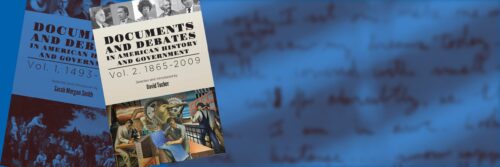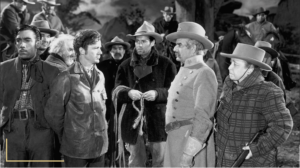
The New Deal: Social Security
Most Americans employed in the private sector have experienced this moment. They looked at their paycheck stub, noted the listed deductions from their gross pay, and wondered, “What the heck is FICA, and why do they get so much of my money?” FICA taxes (Federal Insurance Contributions Act) are taxes collected by the federal government that primarily fund Social Security programs. Some of those funds are allocated to Medicare, health insurance for people over 65 years old. Social Security has changed since Congress first enacted the legislation in 1935. For example, disabled workers initially excluded from receiving benefits may be eligible today. However, one feature remains the same. Social Security taxes assessed on current workers are used to provide some retirement income for the elderly, most of whom are no longer in the workforce. Very few workers in the private sector are exempt. This expansive reach of Social Security makes it perhaps the most enduring legacy of Franklin Roosevelt’s New Deal.
In 1935, a heavily Democratic Congress, intent on implementing FDR’s efforts to address the Great Depression, easily brushed aside all opposition to the Social Security Act. Conservatives worried FDR was putting the nation’s chronically poor on a slippery slope toward government dependence for their very survival. At the same time, many liberals felt the program did not go far enough because it did not mandate a massive redistribution of the wealth from high-income to low-income individuals. FDR, hoping to strike a balance between the two camps, insisted that participants fund the program with their contributions. In theory, workers are purchasing insurance against unexpected gaps in employment and the infirmities of old age. This element of insurance was crucial to FDR. Because participants would receive income based on individual contributions made while working, “no damn politician” would ever have the courage to cut the benefits, he believed.
Indeed, Social Security is called the “third rail” of American politics. Meaning that politicians who dare to propose reforms to the system are more likely to damage their careers than see their proposals succeed. LBJ’s Great Society in the 1960s added Medicare, a proposal FDR failed to include in his original request of Congress. The Reagan administration was able to raise the retirement age for receipt of benefits. These changes involved tinkering with the system, not wholesale changes.
In 2005, President George W. Bush, spurred by his reelection in 2004, stated his intention to reform Social Security. “I earned capital in this campaign, political capital, and now I intend to spend it,” he declared. Bush took his case to the people in a series of events. However, disapproval of Bush’s plan rose from 48% to 54% in a few short months, according to Gallup polls. The remainder of Bush’s political capital was exhausted by the administration’s stumbling response to Hurricane Katrina, thus ending support for Social Security reform
The American Association of Retired Persons (AARP) and other organizations that support seniors fiercely defend Social Security. They lobby against any reduction in benefits. On the other hand, young Americans often express skepticism that they will receive benefits when they retire. Indeed, they argue, the system will be broke by then. They have some worrying statistics on their side. When recipients first began receiving benefits, there were 159 workers for every retiree. Now the ratio is two workers for every recipient.
As younger people shoulder the burden of supporting dramatically increased numbers of retired people, urgent policy choices arise. Should the retirement age be raised? Should the cap on FICA taxes (Currently at $137,000 in income per year) be raised Should legal immigration be expanded? Would the extra workers offset declining birth rates in the US and boost contributions to the system? What impact will automation in American industries have? Will robotic manufacturing continue to replace workers on assembly lines and increase the Social Security burden on the employed? What about the outsourcing of jobs to other nations? Increased aging of the population and accompanying pressure on Medicare expenditures? Today’s students will be wrestling with these questions for the foreseeable future – perhaps their entire lives.
But they may also ask, does Social Security work? Has it lifted seniors out of poverty? One estimate from the Center on Budget and Policy Priorities claims nearly 15 million current seniors—as well as over a million children—are raised over the poverty line by Social Security.
The documents in our Core Document Collection, Chapter 22, The New Deal: Social Security from Volume II of Documents and Debates in American History, help students see the fundamental questions inherent in the debate over the Social Security Act of 1935. What role should the federal government play in helping the unemployed and the aged? When extended families, charities, and state governments appear incapable of meeting the needs of the aged and unemployed, should the social burden shift to the federal government? Students working in their first jobs and experiencing, for the first time, the reality of Social Security taxes will readily connect this particular debate with their everyday lives.
At Teaching American History, we believe students best understand history when they are encouraged to dive into the primary sources, closely reading the words written by the authors of the time and putting their questions to those authors themselves. In this way, students reach their own conclusions about the choices made by Americans of the past. We encourage you to engage your students in a close reading of these documents as they discuss the government’s role in assisting the unemployed and the aged.
Documents in this chapter include:
- President Franklin D. Roosevelt, Speech to Congress on Social Security, January 17, 1935
- Representative James W. Wadsworth (R-NY), Speech on Social Security, April 19, 1935
- Senator Huey P. Long (D-LA), Statement on the Share Our Wealth Society, May 23, 1935
We have also provided audio recordings of the chapter’s Introduction, Documents, and Study Questions. These recordings support literacy development for struggling readers and the comprehension of challenging text for all students.
Teaching American History’s We the Teachers blog will feature chapters from our two-volume Documents and Debates with their accompanying audio recordings each month until recordings of all 29 chapters are complete. In today’s post, we feature Volume II, Chapter 22: The New Deal: Social Security. On February 9, we will highlight Chapter 9: The Hartford Convention from Volume I of Documents and Debates in American History. We invite you to follow this blog closely, so you will be able to take advantage of this new feature as the recordings become available.



